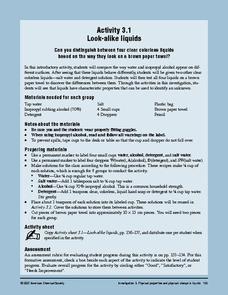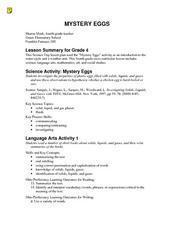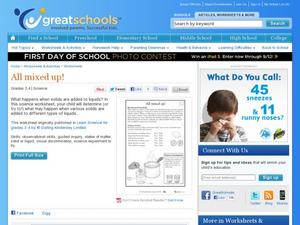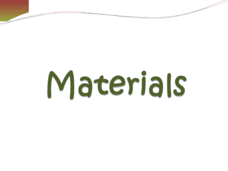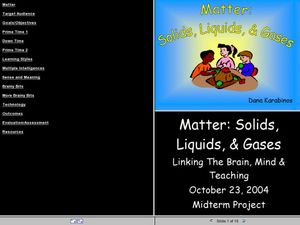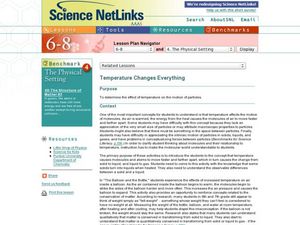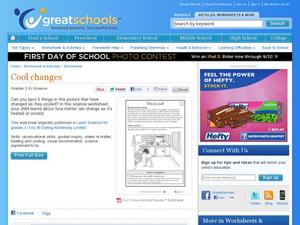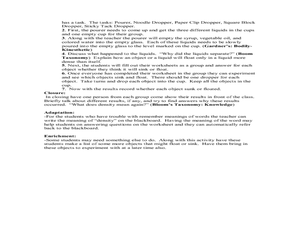American Chemical Society
Look-Alike Liquids
Here is the first of four experiments to differentiate among unknown liquids by their behaviors and properties. Pupils observe how different liquids respond to being placed on plastic and paper, and they take notes about their...
American Chemical Society
Using the Combining Test to Identify Unknown Liquids
Once investigators have learned how their mystery liquids interact with water during the preceding activity, they now use their observations to identify them. This is an ideal conclusion to the mini unit on the properties of water.
American Chemical Society
Using Color to See How Liquids Combine
Blue-tinted water is added to unknown liquids that have been tinted yellow to find out how they interact. This is a memorable activity that is part of an investigation on the properties of liquids, which is part of a unit on the...
Curated OER
Mystery Eggs
Students investigate the properties of plastic eggs filled with solids, liquids, and gases and use these observations to hypothesize whether a chicken egg is hard-boiled or raw.
Curated OER
Engaging Young Scientists with Inquiry: Part One
Building inquiry into your science lessons will make science concepts more concrete for your class.
Curated OER
All Mixed Up!
What happens when solids are added to liquids? After reading an informative paragraph about solutions, learners answer six true/false questions regarding solutions, and what substances will dissolve into liquids they are mixed with. A...
Curated OER
Solids, Liquids, and Gases
In this phases of matter worksheet, students complete 13 fill in the blank spaces with science words from the given word bank. The blanks are placed within an informational paragraph about solids, liquids, and gases.
Curated OER
Liquids and Solids: Materials
Investigate the properties of solid and liquid materials. This very complete slide show is perfect for introducing liquids and solids to children in grades one or two. It describes multiple properties of solids, metals, plastics, wood,...
Curated OER
Matter: Solids, Liquids, and Gases
Review the states of matter with your second graders using this resource. Learners first review what they know about solids, liquids, and gases. Then, they fill out a chart to show what they have learned. Finally, they engage in a...
Curated OER
Temperature Changes Everything
Learners determine the effect of temperature on the motion of particles. They study the difference between particles in a gas, liquid, and a solid and see how the characteristics of solids, liquids, and gases can be explained by particle...
Curated OER
Keep the Wet Out
After reading a short paragraph about certain materials and their ability to repel water, learners answer two questions regarding a variety of materials' ability to repel water. There are six different substances placed in bowls of...
Curated OER
This is Cool!
Third and fourth graders who are studying states of matter will enjoy this simple exercise. In it, they look at a picture of a girl in her kitchen, and they must circle five examples of materials that have changed states of matter as...
Curated OER
Strong Ice
Through three activities, first-time physical scientists wonder at the properties of water. Freeze some soda cans and a container of water prior to the investigation to show that water expands when frozen. Lab groups experiement with...
Curated OER
Cool Liquids
Chemistry neophytes use a temperature probe to assess the change as five different liquids evaporate. The implantation section suggests that they take readings every five seconds for a total of four minutes. They graph the data, look up...
Curated OER
Phases of Matter
Students are introduced to the basic states of matter: solids, liquids and gases. Through experimentation, students determine that liquids and solids have definite volume, that gases do not have definite volume, and that solids have a...
Curated OER
States of Matter
Learners explore the states of matter. They discuss the different phrases of matter and categorize everyday substances as solids, liquids, or gases. Students explore the relationship between the phases on an atomic level and the role of...
Curated OER
Matter
First graders are read a story about the various stages of matter with a focus on gases. Using a ziploc bag, they capture as much air as possible and discuss how it takes up space even though it is invisible. To end the lesson plan, they...
Curated OER
Properties of Liquids
Students describe properties of liquids and use descriptive language as a springboard to develop precise vocabulary for properties of liquids. They also use vocabulary as practiced with liquid-vocabulary card games. Finally, students...
Curated OER
Meet Mr. Gallon
Learners create a sculpture of a Mr. Gallon character to help them remember liquid measurement formulas. They complete a worksheet completing measurement equations, and review their answers together.
Curated OER
What Do Your Know About Matter?
Perfect for 1st grade students, this presentation contains information on the various states of matter, what affects them, and how they change. Using clear language and simple images, these slides will be there to guide any lesson or...
Curated OER
As a Matter of Fact: Solids, Liquids and Gases
Sometimes a simple explanation is best when introducing new concepts. Identify the three states of matter with this presentation. Each slide provides a simple description and examples for each of the three states. Tip: Show students the...
Curated OER
Ready, Set, Let's Dough! It's a Matter of System
Students explore physical sciences by participating in a class experiment. In this matter instructional activity, students identify the three forms of matter and their physical differences. Students utilize cookie dough to create a play...
Curated OER
Solids, Liquids and Gases
In this solids, liquids and gases worksheet, students are given pictures of different substances and their particles. Students cut out the pictures and match the proper particles with the proper substances based on the distances of the...
Curated OER
Liquids: Floating and Sinking
Third graders conduct an experiment. In this floating and sinking liquids lesson, 3rd graders discuss density and investigate it using syrup, vegetable oil and colored water. Students observe the results and complete a worksheet.


